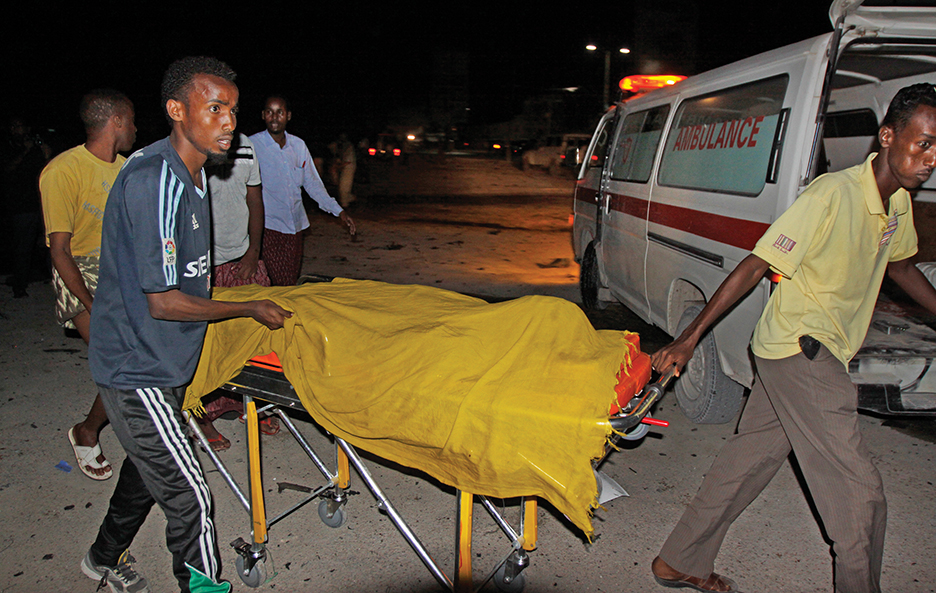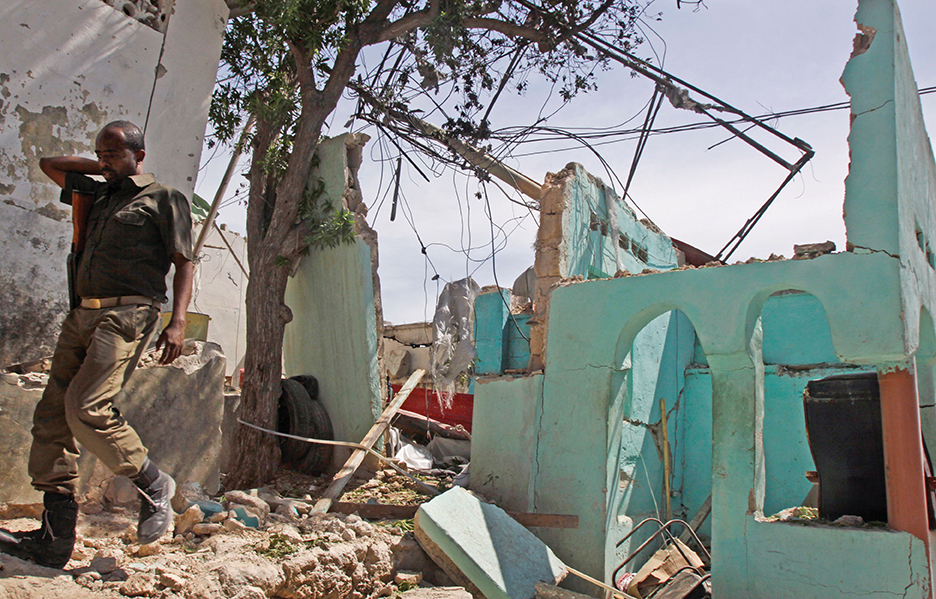An Indiscriminate Killer
IEDs Become the Weapon of Choice in Asymmetric Warfare
On Sunday, December 28, 2014, a sugar cane seller in Potiskum, Nigeria, died when she stepped on a bomb in a school football field. She was 12 years old.
The bomb was planted Sunday to be triggered the next day when the field would be crowded with children. Instead, the girl stepped on it early in the evening, when she was one of the only people on the field.
A few months earlier, a suicide bomber in Nigeria’s Yobe state rode a motorized rickshaw to an outdoor venue, where people watched a televised football match. The bomb detonated, killing at least 21 people.
In both cases, the bombers were Boko Haram extremists using improvised explosive devices (IEDs). The group is said to have a substantial quantity of lethal and explosive chemicals since attacking and raiding a Chinese mining factory in May 2014.
This is the world of asymmetric warfare, in which extremists play by no rules, and targets can be anyone. Extremists want notoriety and inspire fear through indiscriminate, random attacks. For them, the higher the body count, the greater the achievement.
Perhaps the most notorious use of IEDs in Africa came in 2010 during the World Cup final. The Somali extremist group al-Shabaab triggered three IEDs in the Ugandan capital of Kampala, killing 74 people and injuring 70. The bombings targeted football fans watching the games on televisions. A Somali man’s head was found at one site, leading investigators to believe a suicide bomber triggered the blast.
Boko Haram and al-Shabaab are not the only groups using IEDs on the continent. On January 6, 2014, a police officer was killed while trying to defuse an IED planted near a police station in Giza, Egypt, the news website Aswat Masriya reported. Weeks earlier, an IED exploded on a platform at Cairo’s Ramses Railway Station, wounding three people. Such devices have become almost commonplace in Egypt, targeting security forces and public facilities since the ouster of former President Mohamed Morsi. Extremist Islamist groups are behind the bombs, authorities say.
There also were regular reports in 2014 of IEDs being used in Kenya, Libya and northern Mali.

“For bomb makers who use IEDs as a weapon, Africa is now their training ground,” said a spokeswoman for the United States Joint Improvised Explosive Device Defeat Organization (JIEDDO). “They can train without being harassed, hide in plain sight, and practice their new skills on local populations, using IEDs against anyone with whom they have a grievance.”
At least eight African countries — Djibouti, Egypt, Kenya, Libya, Mali, Nigeria, Somalia and Tanzania — reported IED attacks in 2014. JIEDDO researchers said, for the 12 months ending in November 2014, there were 835 African IED events, a decrease of 15 percent from the previous year. Casualties, however, increased 41 percent, with 2,559 people killed and 2,010 wounded.
In 2014, more people were killed by IEDs in Nigeria than in any other African country. For the 12 months ending in November, Nigeria had 124 IED incidents, or 15 percent of the African total, but with 2,569 deaths and injuries, or 56 percent of the total for the continent.
BOOBY TRAPS
IEDs, also known as booby traps and roadside bombs, have been around for a long time. Although the first goal is to maim and kill, IEDs also are designed to create an environment of caution and distrust. They are highly effective at slowing troop movements. They have been described as the ultimate devices for psychological warfare.
Nigeria and Somalia are particular hot spots for IEDs. In Somalia, the weapons, probably assembled by members of al-Shabaab, are filled with military explosives such as cyclotrimethylene variants and pentaerythritol tetranitrates. They generally use commercial electric blasting caps. According to the American Terrorist Explosive Device Analytical Center (TEDAC), insurgents usually trigger IEDs with motorcycle alarms or cellphones. The radio-controlled motorcycle alarms are inexpensive, usually made in China, with tiny, inconspicuous remote controls.
Al-Shabaab tends to use ball bearings in its IEDs. When the devices are triggered, the blast sends the ball bearings out like bullets. More recently, seizures of such ball bearings have forced al-Shabaab to switch to other fragmentation materials, including small pieces of steel concrete reinforcement bars known as rebar.
Al-Shabaab began using anti-armor IEDs in mid-2011. They have been effective against lightly armored vehicles because of the power of the devices and a scarcity of effective countermeasures. The al-Shabaab IEDs have since been found in Uganda and Kenya as well.
Military bomb expert John Myrick told The Associated Press that the more effective bombs and attacks in Somalia “indicate an increase in logistical support from some of the more sophisticated groups on the continent and also an increase in training.”

Investigators say that, compared with IEDs found in other parts of the world, the al-Shabaab IEDs are of relatively poor quality and construction. Instead of the preferred method of wirelessly triggering IEDs, some of the devices use riskier direct wiring. One team of Uganda People’s Defence Force Soldiers identified three men along a road as being in the triggerman and spotter positions to detonate an IED. They found the IED buried in the road, with 160 meters of wire leading to the triggerman position.
The devices typically are triggered by a pressure plate, often mounted atop a spring so that the weight of a passing Soldier or vehicle will compress the spring, completing a circuit and triggering the device.
IEDs recovered in Africa have been rigged with a variety of crude triggers. They have included pressure plates rigged with metal sheets separated by pieces of paper, pressure plates using saw blades, and bombs rigged with salvaged rocker switches like those found in a house to turn the lights on and off.
SOPHISTICATED TECHNIQUES
Even in cases where extremists use crude IEDs, their tactics, honed by experience, are getting more sophisticated. In March 2013, a bomb disposal unit found IEDs rigged to a motorcycle alarm in the coastal city of Merca in Somalia. The unit reported that one device was buried deeper than usual, probably to prevent detection by bomb-sniffing dogs. It was also unusual in that it had two main charges instead of one. The bomb unit also reported that a second IED was employed as bait, placed in such a spot that the bomb-recovery vehicle would have been parked directly over the actual IED while dealing with the bait device.
The IEDs assembled in Somalia may be crude, but they are effective. In 2013 and 2014, al-Shabaab IED targets included United Nations workers and facilities, and Aden Adde International Airport. For the year ending October 1, 2014, Somalia had 432 IED incidents with 1,251 casualties.

Somali IEDs usually contain explosives taken from artillery rounds or mines. However, TEDAC investigators have found homemade explosives in some devices, and mixes of military and commercial-grade explosives.
An IED can be almost anything that has material that can cause injury, and something to make it blow up. The variations are endless, including devices made from existing weapons or “homemade” explosives.
The main charge is often made from military munitions, including the plastic explosives C-4 and PE4, but other materials can be adapted, including the civilian explosive TNT. An explosive can be made from ammonium nitrate, found in ordinary fertilizer. Reactive chemicals and flammables such as gasoline also can be used to make IEDs.
THREE TYPES OF IEDS
Experts generally classify IEDs into three groups:

Package Type IEDs include homemade bombs and devices made from existing weapons and explosives. They are typically thrown at targets or hidden along roads or in buildings. The builders of package IEDs have become quite inventive in disguising them, making them look like such things as construction material or cement blocks. The IED container can be almost anything, from an empty soda can to an animal carcass.
Vehicle-borne IEDs, or VBIEDs, use a vehicle as the package or container that delivers explosives to the target. The vehicles can range from large trucks down to donkey-drawn carts. The larger the vehicle, the larger the amount of explosives that can be moved. In 2011, a van packed with explosives was driven to the United Nations building in Abuja, Nigeria, where it was detonated, killing 23 people and injuring 76. It is believed to have been Nigeria’s first VBIED.
Suicide bomb IEDs are designed to have a high-explosive or fragmentary effect. Although the person wearing the bomb typically dies, the goal is to take out as many Soldiers and civilians as possible. The person wearing the bomb usually detonates the device using a hand-held switch or button. When a suicide bomber is discovered, deadly force is generally the only option. Soldiers trying to stop a suicide bomber should fire their weapons from a protected position or from as far away as possible.

Al-Shabaab has used suicide vests for years. TEDAC reports that there are some signature designs common to some of the vests, such as a particular type of knot used to secure wire connections, or nine-pin male-female quick-connect devices such as those used in car stereos, or white plastic rocker switches.
Regardless of the type of IED, they have common designs, including a switch trigger, a fuse, a main charge, a power source for the trigger and a container.
There are basically two types of triggering devices — electric and manual. Electric firing devices are almost limitless in their variations, but they always require a power source, usually a battery. If the battery fails, the IED cannot be deployed.
Manual triggering devices are more basic and less varied. Mechanical triggers require pressure, pressure release, a pin removal or trip-wire activation.
TECHNIQUES TO LOOK OUT FOR
The very name of IEDs — “improvised” — shows how varied these devices can be. GlobalSecurity.org says there are some practiced techniques to look out for:
Coupling is the linking of one explosive to others, usually with a detonating cord. When the first explosive is detonated, it detonates the linked explosives. This technique is used to disable anti-mining equipment.
Rolling is as much a tactic as a technique. A vehicle will pass safely over an initial explosive device, but set off a second fused explosive, directly under the vehicle or the one behind it. This second explosive will then set off the first. When this tactic is used with directional fragmentation mines, the results can be devastating.
Boosting is when mines, often salvaged, are buried in stacks. Only the bottom explosive, the one buried the deepest, is fused. This makes the stack difficult to detect and, when detonated, increases the force of the explosion.
Daisy chaining involves linking small anti-personnel mines and equipping them with trip wire or a detonating cord. When one mine is tripped, the rest of the mines also detonate, creating a large, lethal area.
 Anti-tank mines are designed to be detonated by the weight of tanks, not Soldiers. Sensitizing nonmetallic anti-tank mines involves cracking open the pressure plate that triggers the device, and removing the spring, greatly reducing the pressure needed to detonate a device powerful enough to take out a tank. Removing the pressure plate entirely from metallic anti-tank mines has the same effect. Or, a small anti-personnel mine can be rigged to trigger a much larger anti-tank mine.
Anti-tank mines are designed to be detonated by the weight of tanks, not Soldiers. Sensitizing nonmetallic anti-tank mines involves cracking open the pressure plate that triggers the device, and removing the spring, greatly reducing the pressure needed to detonate a device powerful enough to take out a tank. Removing the pressure plate entirely from metallic anti-tank mines has the same effect. Or, a small anti-personnel mine can be rigged to trigger a much larger anti-tank mine.
HAND GRENADES AS IEDs
Extremists have been converting hand grenades to IEDs for decades. Ordinarily, grenades are tossed into buildings or from bridges. But when they are rigged as booby traps, Soldiers have to take special precautions.
The grenade in a can was one of the first adaptions as an IED. A grenade’s safety pin is removed, its safety lever is compressed, and the grenade is put in a metal can or other container. A string or tripwire is rigged across a path or tied to something such as a doorknob. When the string is pulled, the safety lever is released, detonating the grenade.
The glass jar grenade is nothing more than removing the safety pin of a grenade and putting the grenade in a heavy glass jar that holds back the safety lever. The grenade will then only detonate when the glass is broken, making it ideal for dropping from heights, or putting in the path of vehicles.
The rubber band grenade is fire-activated. The safety pin of the grenade is removed, and the safety lever is tied down with a strong rubber band. The device is placed in an area that is expected to be burned by the enemy or in an area where the bomber can start the fire. When the rubber band burns away, the grenade ignites.
Taking precautions with IEDs
ADF STAFF
A bomb squad officer approached a suspicious plastic bag in the Nigerian city of Kaduna. Wearing no protective gear, he looked inside the bag, which exploded, killing him. The state-run Nigerian Television Authority recorded the incident.
Experts say this death on February 14, 2012, could have been prevented through better training.
Soldiers have been studying IEDs and land mines for years, searching for ways to survive them. A few precautions have stood the test of time:
~ All Soldiers in high-risk areas should have training in the various types of IEDs and how to detect them. For example, during the Vietnam War, Viet Cong fighters noticed that American Soldiers were in the habit of kicking empty soda cans. The Viet Cong rigged empty cans with IEDs that triggered when kicked.
~ All Soldiers should have training in first aid. They need to know how injuries are caused by the pressure wave of the primary blast, the multiple types of wounds caused by the secondary blast, and injuries resulting from being thrown by the blast. Training in the treatment of shock is especially important.
~ Soldiers in risk areas should wear flak jackets and helmets at all times.
~ Vehicles employed in high-risk areas should be equipped with bags of fine sand on their floors as protection. Any material larger than fine sand becomes a missile in the event of an explosion.
~ When the situation allows it, passengers in armored vehicles should ride on top, rather than inside. Hatches on armored vehicles should be left cracked open, with the latch pin still in place, to permit the dispersion of the concussion of an IED explosion.
~ Any IED incidents should be reported immediately. The reporting should go beyond traditional intelligence channels; the military unit should have an IED/land mine information and coordination unit in place.
~ Foot Soldiers should be on the lookout for things that appear too easy — or too interesting. Things that might be considered war souvenirs or valuables are commonly rigged as triggering devices. Soldiers should be trained to be wary. The same is true of a single open door in an otherwise secured building. If it is necessary to occupy an empty building, it should be assumed that the building has been rigged with IEDs.
~ The somewhat-cleared foot path through an otherwise difficult-to-negotiate street or field is an obvious place for IEDs.
~ Other markers for planted IEDs include footprints that end abruptly, disturbed soil or sand, isolated boxes along a trail, abandoned vehicles and military equipment, and street trash that includes wires, strings, and bits of steel.
~ Screening pedestrians and drivers remains a key element of preventing the use of IEDs. In November 2014, security officers were searching pedestrians’ bags at the gate of a frequently targeted area in Gombe, Nigeria, when a man tried to charge past. Onlookers overpowered the man, who was found to be armed with IEDs. Nigerian news outlets reported that a crowd burned the man alive on the spot.


Comments are closed.